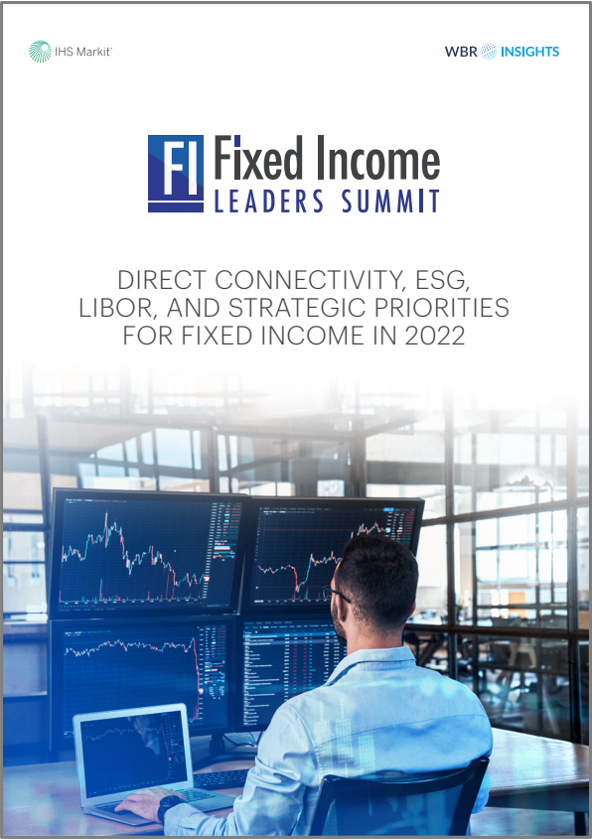Customer Logins
Obtain the data you need to make the most informed decisions by accessing our extensive portfolio of information, analytics, and expertise. Sign in to the product or service center of your choice.
Customer Logins
BLOG
Nov 10, 2021
Tech and Data Innovations: Unlocking Trading Desk Efficiencies
The following Q&A with Brett Schechterman (Managing Director, Global Head of thinkFolio, IHS Markit) and Karthick Chandrasekaran (Executive Director, EMEA Business Development, IHS Markit) was originally published as part of a white paper produced by the organizers of the Fixed Income Leaders Summit.
What are the major themes you are observing within the buy-side trading community?
Buy-side teams have coped incredibly well with pandemic-induced workplace change. To have been successful in 2020 meant that one had to ensure operational resiliency, ongoing access to liquidity and optimal cross-asset execution scale. As organizations settle into the new normal of hybrid working, we hear heads of desks making investments in areas that will make them more agile and efficient. As policy on rates remains soft, there is increased pressure to generate alpha and drive operating costs lower.
We have observed several key trends, each of which is at a different stage of maturity. Trading desk efficiency is paramount, traditional trading models are being questioned and firms are targeting step change in operational alpha and scalability. We saw the pandemic accelerate consideration for outsourced trading solutions and further adoption of electronic all-to-all trading protocols and portfolio trading. It also prompted a push towards multi-asset Order and Execution Management System (O/EMS) solutions and further integration of cross-asset pre-trade intelligence. Additionally, with a need for traders to focus on higher-value tasks, we see increased investment in trade automation through leveraging machine learning (ML) and artificial intelligence (AI), along with a desire to digitize and align primary and secondary market workflows.
As customers strive to maximize efficiencies, what are the areas in which you see innovation?
The systems and tools utilized to access and engage in primary and secondary market activity have limited - if any - interaction between them. Trading desks will typically follow a completely different process when conducting decision support and managing orders for primary market activity when compared to secondary. The former is more manual and resource intensive, and customers are seeking ways in which primary can become more efficient and integrated into the same platforms used for secondary workflows. We see customers questioning the status quo, which has driven significant technology investment focused on merging these workflows.
How is IHS Markit helping firms achieve their objectives with technology and market data intelligence?
As institutional investors seek greater efficiencies, they are not only looking for alignment of primary and secondary workflows, but also more timely, seamless navigation and transition between primary and secondary decision lenses. We are helping customers achieve this in several ways.
Our InvestorAccess platform was the first service to connect the buy-side and sell-side such that deal information, orders and allocations can now flow electronically between investors and the banks' primary deal platforms. We have taken the next step to allow buy-side platforms (starting with our own thinkFolio) to integrate the InvestorAccess network so that investors can manage all of their primary and secondary workflow in one place. This collaboration and end-to-end electronification results in streamlined workflows, reduced operational risk, and enhanced compliance and audit capabilities for our clients' dealing operations.
Further, we see a unique opportunity to integrate our rich universe of cross-asset pricing and liquidity intelligence to enrich decision support analyses for customers using our software. For example, thinkFolio customers will be able to seamlessly monitor and engage in the primary market opportunity set through the InvestorAccess integration, while also having the ability to leverage our full suite of secondary market sector and issuer intelligence to aid them in pre-trade and relative value analyses. This can all be delivered via a single, interoperable desktop, end-to-end digitized workflow and enhanced user experience.
How is the front office's appetite for data and analytics evolving? For which types of data and analytics services do you see the most demand?
We see increasing demand for pricing analytics and liquidity data that is dynamically updated across the full range of Fixed Income asset classes (bonds, loans, credit default swaps (CDS), etc.). This interest can be attributed to desire for further electronification and recognition that better pretrade information can drive trade automation efficiencies, strengthen best execution confidence and unlock additional liquidity.
The buy-side has increased acceptance to look beyond execution platforms alone and to utilize leading pricing sources and liquidity data to enrich their tool kits. Leading pricing providers can proficiently collect and clean unstructured data and create a composite pricing that is updated throughout the trading day. Furthermore, they can use technology to extrapolate observed data points on liquid bonds to imply movement in the illiquid counterparts helping to identify dislocations of price and relative value.
For more on these topics, please download the full paper below:
S&P Global provides industry-leading data, software and technology platforms and managed services to tackle some of the most difficult challenges in financial markets. We help our customers better understand complicated markets, reduce risk, operate more efficiently and comply with financial regulation.
This article was published by S&P Global Market Intelligence and not by S&P Global Ratings, which is a separately managed division of S&P Global.
{"items" : [
{"name":"share","enabled":true,"desc":"<strong>Share</strong>","mobdesc":"Share","options":[ {"name":"facebook","url":"https://www.facebook.com/sharer.php?u=http%3a%2f%2fstage.www.spglobal.com%2fmarketintelligence%2fen%2fmi%2fresearch-analysis%2ffixed-income-tech-and-data-priorities-2022-qa.html","enabled":true},{"name":"twitter","url":"https://twitter.com/intent/tweet?url=http%3a%2f%2fstage.www.spglobal.com%2fmarketintelligence%2fen%2fmi%2fresearch-analysis%2ffixed-income-tech-and-data-priorities-2022-qa.html&text=Tech+and+Data+Innovations%3a+Unlocking+Trading+Desk+Efficiencies+%7c+S%26P+Global+","enabled":true},{"name":"linkedin","url":"https://www.linkedin.com/sharing/share-offsite/?url=http%3a%2f%2fstage.www.spglobal.com%2fmarketintelligence%2fen%2fmi%2fresearch-analysis%2ffixed-income-tech-and-data-priorities-2022-qa.html","enabled":true},{"name":"email","url":"?subject=Tech and Data Innovations: Unlocking Trading Desk Efficiencies | S&P Global &body=http%3a%2f%2fstage.www.spglobal.com%2fmarketintelligence%2fen%2fmi%2fresearch-analysis%2ffixed-income-tech-and-data-priorities-2022-qa.html","enabled":true},{"name":"whatsapp","url":"https://api.whatsapp.com/send?text=Tech+and+Data+Innovations%3a+Unlocking+Trading+Desk+Efficiencies+%7c+S%26P+Global+ http%3a%2f%2fstage.www.spglobal.com%2fmarketintelligence%2fen%2fmi%2fresearch-analysis%2ffixed-income-tech-and-data-priorities-2022-qa.html","enabled":true}]}, {"name":"rtt","enabled":true,"mobdesc":"Top"}
]}






